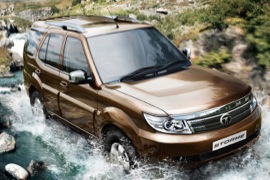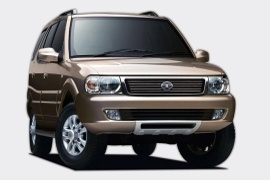TATA MOTORS Safari Models/Series Timeline, Specifications & Photos
First production year: 2005
Engines: Diesel, Gasoline
Body style: SUV (Sports Utility Vehicle)
The Tata Safari was introduced on the market in 1998 and it featured a body-on-frame structure that was kept along the way. It was transferred to the 2012 model Safari Storm, which was very similar.
Tata is one of the biggest car-maker in India and it owns the Jaguar-Land Rover group. Despite having one of the most experienced off-road brands in the world, it didn't rebadge one of the British vehicles. It just improved the existing Safari.
The exterior look is very similar to the original, 1998, Safari. The front and the rear were changed. A new pair of headlights with clear lenses were introduced. In the back, the biggest change was the removal of the tailgate-mounted spare wheel. It was moved under the floor. From the side, the only change was to the rear-view mirror cases, which were chromed. The high step inside the car was kept, but it was a price paid for the big ground clearance.
Inside, the Tata said that not a single screw or bolt was carried-over from the non-facelifted version. Apart from the after-market look of the CD-radio installed in the center stack, everything else looked better. A new finish in wood grain, chromed lines, and better finishes were the main improvements brought by the Safari Storm. The leather upholstery was offered as an option. In the trunk area, the Storm offered two additional side-mounted seats.
Under the hood, the Safari Storm offered a new 2.2-liter diesel engine with a variable turbocharger that offered 156 hp. It was mated as standard to a 6-speed manual. The braking system was upgraded with disc-brakes in all four corners. It was available as a 4x2 or a 4x4 traction system.
Tata Motors was far from reaching international credits in 2005 when introducing the facelifted version for the Safari SUV model.
The Safari came on the Indian market in 1988, and it was the first original Indian SUV. It was an instant success and, thanks to the 2.2-liter turbo-diesel version, it made it on the European continent, where its sales were slow. Still, the carmaker continued producing it for its home market, where it checked the top of the sales charts in its segment. In 2005, the carmaker brought a second generation, which mainly looked like the first generation, but with better engines.
The car received new, wrapped-around plastic bumpers and a redesigned grille with a chromed surrounding on the outside. Its horizontal headlights featured corner-mounted turn signals with clear lenses. A set of body-colored plastic moldings enhanced the car's look on the sides, along with a set of side steps. Its roofline featured a higher area over the trunk, resembling the Land Rover Discovery I, but that raise was needed to make room for additional passengers.
Inside, Tata installed a five or seven seats interior, with two jump-seats behind the rear bench. The dashboard featured a clean design with aluminum-like trims on the center stack. The carmaker installed two large dials for the speedometer and tachometer and two gauges for the fuel level and coolant temperature in the instrument panel. But, despite the decent design, the material's quality was not among the best in class.
Under the hood, the most significant update was the naturally aspirated 3.0-liter diesel for the home market and a PSA-sourced 1.9-liter turbo-diesel powerplant. A gasoline-powered version was also available but offered an awful fuel efficiency.

